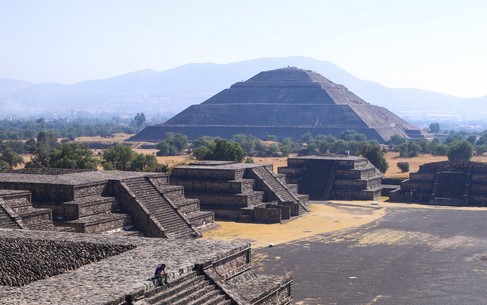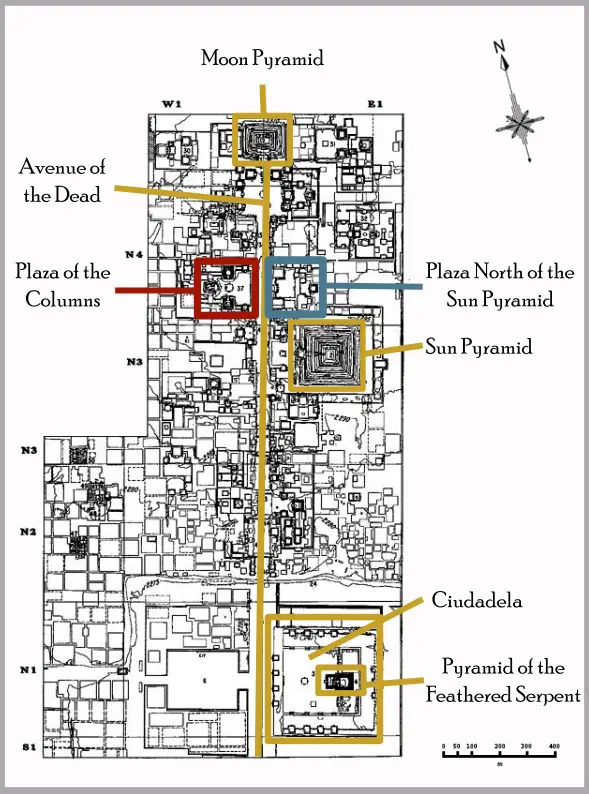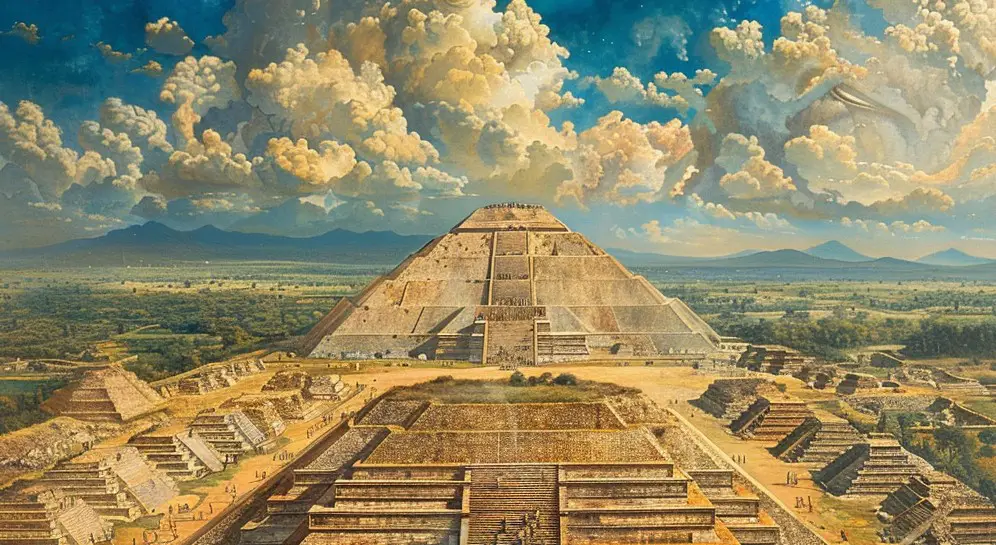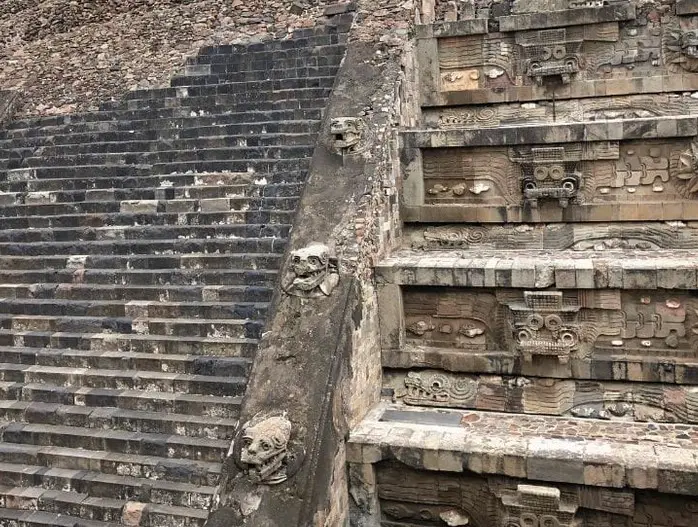Podcast: Play in new window | Download
Subscribe: Apple Podcasts | RSS
 Teotihuacan, located in the Valley of Mexico, flourished as one of the largest and most influential cities in the pre-Columbian Americas between the 1st and 7th centuries AD. Renowned for its monumental architecture, including the iconic Pyramid of the Sun and Pyramid of the Moon, Teotihuacan boasted a sophisticated urban layout, advanced infrastructure, and a diverse population that some scholars believe was almost 200,000 inhabitants at its peak. The city served as a hub for trade, religion, and culture, with evidence suggesting its influence extended across Mesoamerica to as far away as modern-day central Guatemala. Despite its monumental structures and extensive urban planning, much about Teotihuacan remains shrouded in mystery, including the identity of its rulers, the reasons for its eventual decline, and the cultural practices of its inhabitants. Excavations and ongoing research continue to unveil historical glimpses of this ancient metropolis, offering invaluable insights into the complexities of Mesoamerican civilization. In this episode we will look at what 21st Century archaeologists know about 3 distinct neighborhoods in this ancient mega-city: an elite quarter for nobility, a thriving middle-class enclave which was home to many immigrants, and a working-class barrio which housed tradesmen who were vital to Teotihuacan’s economy.
Teotihuacan, located in the Valley of Mexico, flourished as one of the largest and most influential cities in the pre-Columbian Americas between the 1st and 7th centuries AD. Renowned for its monumental architecture, including the iconic Pyramid of the Sun and Pyramid of the Moon, Teotihuacan boasted a sophisticated urban layout, advanced infrastructure, and a diverse population that some scholars believe was almost 200,000 inhabitants at its peak. The city served as a hub for trade, religion, and culture, with evidence suggesting its influence extended across Mesoamerica to as far away as modern-day central Guatemala. Despite its monumental structures and extensive urban planning, much about Teotihuacan remains shrouded in mystery, including the identity of its rulers, the reasons for its eventual decline, and the cultural practices of its inhabitants. Excavations and ongoing research continue to unveil historical glimpses of this ancient metropolis, offering invaluable insights into the complexities of Mesoamerican civilization. In this episode we will look at what 21st Century archaeologists know about 3 distinct neighborhoods in this ancient mega-city: an elite quarter for nobility, a thriving middle-class enclave which was home to many immigrants, and a working-class barrio which housed tradesmen who were vital to Teotihuacan’s economy.
Much of what has been written about ancient Mexico, especially in the early years of archaeology, has focused on the elites. With monuments to themselves carved in stone, from the highlands of central Mexico to the steamy jungles of the Maya lowlands, the indigenous ancient ruling classes loved to record stories of their conquests, marriages and mythical origins to be put on display for all to see. We see them now, sometimes thousands of years later, and together with what is found in elite burials and households, researchers have a somewhat clear idea of what life was like for the rulers of the ancient cities now in ruin. At Teotihuacan, extensive excavations have been conducted in the area known as the neighborhood for the nobility, located some several hundred yards west of the Pyramid of the Sun. This area has been known since the 19th Century as the Plaza of the Columns, named for the beautifully carved stone columns found in this zone which have long since disappeared. Just the proximity of this barrio to the civic-ceremonial core of this important city suggests elite status, and the archaeological record confirms this. From 2015 to 2022, archaeologists excavated three buildings in this Plaza of the Columns neighborhood and the finds show that the area was home to the super-elites of the city, possibly the ruler and his family, along with other high-status Teotihuacanos. Perhaps the most amazing find in this series of digs was a collection of tools made of human bone. Although researchers are baffled as to their use, such artifacts are very rarely  found in any ancient Mexican archaeological site. Near the place where the bone tools were found, archaeologists cut a trench into a large hill that is covered in nopal cactus. The untrained eye would not know that this is Teotihuacan’s 4th largest pyramid. In the center of this hill archaeologists found a cache of elite goods such as items made of obsidian and jade, and finer examples of pottery, that were most likely left by priests and nobles during the building’s initial dedication ceremony. This discovery is nearly identical to others found in the centers of the other major monuments at Teotihuacan. Additionally, archaeologists found abundant pottery fragments in what would have been on the outside of the pyramid from pottery vessels originating in the Maya area of the lowlands of Guatemala. These fragments were dated to 350 AD, to the height of Teotihuacan’s power. Just north of the small pyramid, archaeologists found evidence of a mural on a wall done in a distinctive Maya style. Some researchers believe that the artist or artists who created the mural may have been commissioned out of one of the Maya cities and traveled hundreds of miles to Teotihuacan for this specific project. Imagine the resources it would take to hire such a prized artist or group of artists from so far away. Even farther afield, pieces of turquoise have been found here which can be traced to mines in the American Southwest located some 1,200 miles away. With all the other luxury goods and artifacts symbolizing high status found in and around the Plaza of the Columns, it is clear that this barrio was the most privileged of all the city’s 88 neighborhoods.
found in any ancient Mexican archaeological site. Near the place where the bone tools were found, archaeologists cut a trench into a large hill that is covered in nopal cactus. The untrained eye would not know that this is Teotihuacan’s 4th largest pyramid. In the center of this hill archaeologists found a cache of elite goods such as items made of obsidian and jade, and finer examples of pottery, that were most likely left by priests and nobles during the building’s initial dedication ceremony. This discovery is nearly identical to others found in the centers of the other major monuments at Teotihuacan. Additionally, archaeologists found abundant pottery fragments in what would have been on the outside of the pyramid from pottery vessels originating in the Maya area of the lowlands of Guatemala. These fragments were dated to 350 AD, to the height of Teotihuacan’s power. Just north of the small pyramid, archaeologists found evidence of a mural on a wall done in a distinctive Maya style. Some researchers believe that the artist or artists who created the mural may have been commissioned out of one of the Maya cities and traveled hundreds of miles to Teotihuacan for this specific project. Imagine the resources it would take to hire such a prized artist or group of artists from so far away. Even farther afield, pieces of turquoise have been found here which can be traced to mines in the American Southwest located some 1,200 miles away. With all the other luxury goods and artifacts symbolizing high status found in and around the Plaza of the Columns, it is clear that this barrio was the most privileged of all the city’s 88 neighborhoods.
About a mile and a half south of the elite quarter of Teotihuacan is the ancient neighborhood researchers now call Teopancazco. Linda Manzanilla, a Mexican archaeologist who has been working at Teotihuacan for over four decades, has been overseeing the digs at Teopancazco in recent years. She believes that the neighborhood was divided into three areas: one in which crafts were produced, one area reserved for religious ceremonies and celebrations, and another which concentrated on food preparation and service, perhaps an ancient restaurant district? Some 116 skeletons have been recovered from Teopancazco and DNA evidence shows that while many of these ancient inhabitants were native to Teotihuacan, others came from nearby regions in central Mexico and from as far away as the gulf coast some 200 miles away. Analysis of the skeletons showed that some people used their front teeth to work with fibers, which many indigenous people still do today to make fishing nets. Tools for fashioning the nets were also found at Teopancazco along with remains of fish and shellfish from the gulf coast, the Caribbean and the Pacific. The net-making industry was most likely not the most important activity in the Teopancazco neighborhood, though. Tools to make garments – such as bone needles and pins – and fragments of feathers and semi-precious stones found in some workshops in the barrio lead researchers to believe that manufacturing high-end clothing was also important in Teopancazco. With the amount of trade Teotihuacan was involved in, it is quite possible that these garments were produced for export and this ancient central Mexican haute couture may have been worn as far away as the Mayan regions of modern-day Central America. The skeletons discovered here also show a great deal of deformities brought on by repetitive motion injuries and by carrying heavy loads. Teopancazco was a neighborhood of workers, which, given their specialties and artifacts found here, were what would have constituted a sort of middle-class at Teotihuacan. In her years of excavating this area of the city, Dr. Manzanilla has also uncovered buildings that she believes could have served as medical, administrative or military facilities, but overwhelmingly, the main industries of this substantial barrio consisted of activities centered around fishing and fashion.
 In the southern edge of Teotihuacan, about a mile and a half from the famous Feathered Serpent Pyramid is the ancient neighborhood known today as Tlajinga. The Tlajinga barrio was one of the city’s poorest neighborhoods, but it served an important role. Located about a day’s walk from two important obsidian deposits, it was at Tlajinga where the bulk of Teotihuacan’s manufacturing of obsidian goods took place. The most important good manufactured here is what scholars call the obsidian core. An obsidian core is a standardized shape of the volcanic glass that could be chipped into other things such as spear points and blades. These cores were a sort of finished raw material that were exported to other parts of ancient Mexico. Making them was laborious, rough work, with a lot of chipping involved along with a high probability of injury to hands and eyes. As other cities throughout Mesoamerica needed obsidian to make cutting tools, Teotihuacan’s trade in these volcanic glass cores was important to the city’s economy and obsidian tools chipped out of these cores have been found in excavations over a thousand miles away from the city. The workers who processed this highly prized and highly necessary commodity lived in apartment complexes similar to those found in 90% of Teotihuacan’s 87 other neighborhoods. Living space per family at Tlajinga was slightly smaller than the rest of the city, though, and residences were made with less cut stone than other barrios and with less lime plaster. These clues indicate to researchers that Tlajinga residents were probably occupying the lower rungs of the economic ladder of this mighty ancient city. Apartment complexes at Tlajinga were square or rectangular and walls were usually 100 to 400 feet long. Sleeping rooms and workshops were arranged around a central courtyard. Burials at Tlajinga show few luxury goods, although some semi-precious stones and marine shells have been found, indicating that some residents of this lower-end barrio did have access to some items the elites enjoyed. Although Tlajinga is considered to be one of the poorest neighborhoods at Teotihuacan, it is important to note that the standard of living in this neighborhood at the time of Teotihuacan’s height was better than that of over 95% of all people living in ancient Mexico at the time, and residents had it even better than how elites were living in faraway kingdoms or in villages not associated with such an organized degree of civilization.
In the southern edge of Teotihuacan, about a mile and a half from the famous Feathered Serpent Pyramid is the ancient neighborhood known today as Tlajinga. The Tlajinga barrio was one of the city’s poorest neighborhoods, but it served an important role. Located about a day’s walk from two important obsidian deposits, it was at Tlajinga where the bulk of Teotihuacan’s manufacturing of obsidian goods took place. The most important good manufactured here is what scholars call the obsidian core. An obsidian core is a standardized shape of the volcanic glass that could be chipped into other things such as spear points and blades. These cores were a sort of finished raw material that were exported to other parts of ancient Mexico. Making them was laborious, rough work, with a lot of chipping involved along with a high probability of injury to hands and eyes. As other cities throughout Mesoamerica needed obsidian to make cutting tools, Teotihuacan’s trade in these volcanic glass cores was important to the city’s economy and obsidian tools chipped out of these cores have been found in excavations over a thousand miles away from the city. The workers who processed this highly prized and highly necessary commodity lived in apartment complexes similar to those found in 90% of Teotihuacan’s 87 other neighborhoods. Living space per family at Tlajinga was slightly smaller than the rest of the city, though, and residences were made with less cut stone than other barrios and with less lime plaster. These clues indicate to researchers that Tlajinga residents were probably occupying the lower rungs of the economic ladder of this mighty ancient city. Apartment complexes at Tlajinga were square or rectangular and walls were usually 100 to 400 feet long. Sleeping rooms and workshops were arranged around a central courtyard. Burials at Tlajinga show few luxury goods, although some semi-precious stones and marine shells have been found, indicating that some residents of this lower-end barrio did have access to some items the elites enjoyed. Although Tlajinga is considered to be one of the poorest neighborhoods at Teotihuacan, it is important to note that the standard of living in this neighborhood at the time of Teotihuacan’s height was better than that of over 95% of all people living in ancient Mexico at the time, and residents had it even better than how elites were living in faraway kingdoms or in villages not associated with such an organized degree of civilization.
 It is interesting to note that the Great Fire of Teotihuacan that destroyed huge parts of the city sometime between the years 550 and 600 AD left the poorer barrio of Tlajinga untouched. The previously mentioned neighborhoods – the elite Plaza of the Columns and the middle-class Teopancazco – were damaged extensively by these fires. Some researchers believe that the poorer classes in the city rose up and tried to take power away from the elites and better-off middle-class, something not unheard of in history and something found in other parts of the world. In any case, by the time of the Great Fire, Teotihuacan was already in a mild state of decline. The fire seemed to act as an accelerant, and a few centuries later only a fraction of the previous population lived there, and the grandeur of the mighty city was gone. As with so many stories of the collapse of ancient civilizations, researchers are still speculating as to what happened at Teotihuacan. There are many more neighborhoods yet to be excavated and studied, and perhaps with further research more secrets will reveal a more complete history of this enigmatic place.
It is interesting to note that the Great Fire of Teotihuacan that destroyed huge parts of the city sometime between the years 550 and 600 AD left the poorer barrio of Tlajinga untouched. The previously mentioned neighborhoods – the elite Plaza of the Columns and the middle-class Teopancazco – were damaged extensively by these fires. Some researchers believe that the poorer classes in the city rose up and tried to take power away from the elites and better-off middle-class, something not unheard of in history and something found in other parts of the world. In any case, by the time of the Great Fire, Teotihuacan was already in a mild state of decline. The fire seemed to act as an accelerant, and a few centuries later only a fraction of the previous population lived there, and the grandeur of the mighty city was gone. As with so many stories of the collapse of ancient civilizations, researchers are still speculating as to what happened at Teotihuacan. There are many more neighborhoods yet to be excavated and studied, and perhaps with further research more secrets will reveal a more complete history of this enigmatic place.
REFERENCES
Plaza of the Columns Project web site: http://ppcteotihuacan.org/en/home/
Zorich, Zach. “Life in the City of the Gods.” Archaeology, vol. 72, no. 6, 2019, pp. 24–31.
